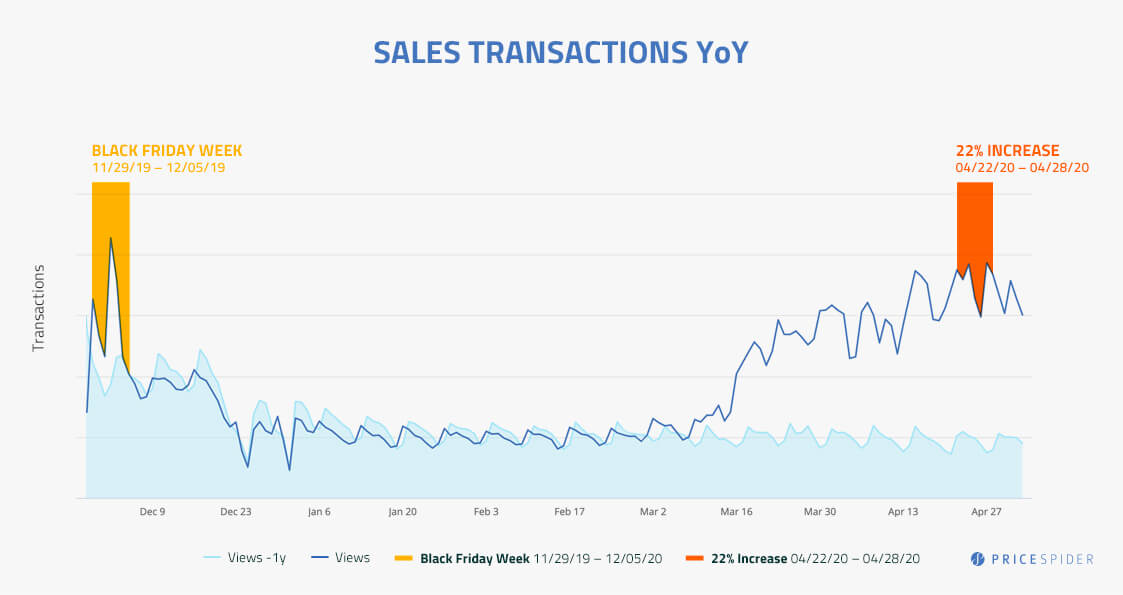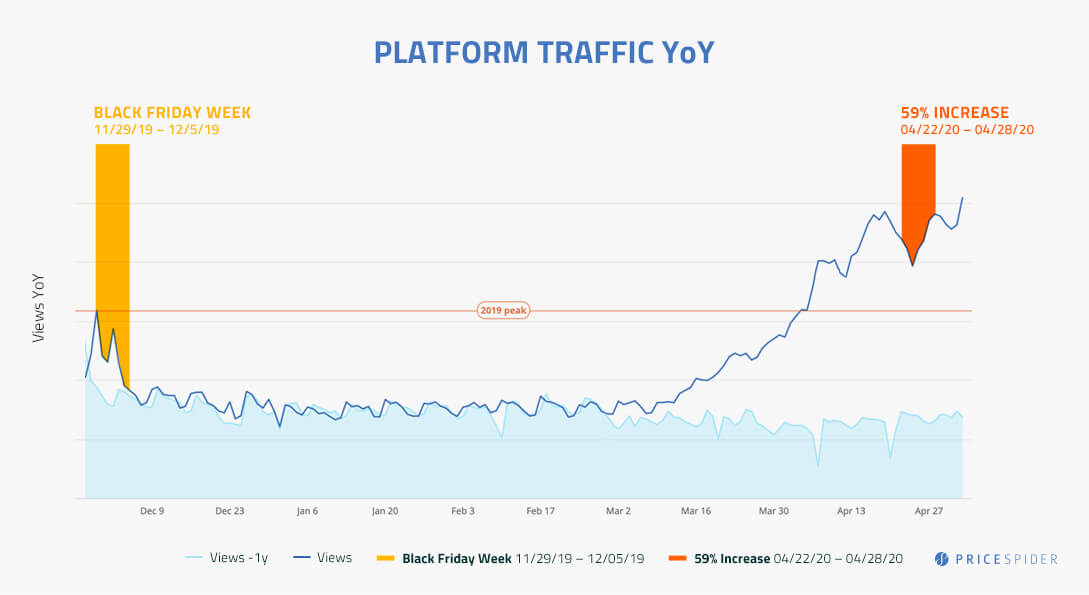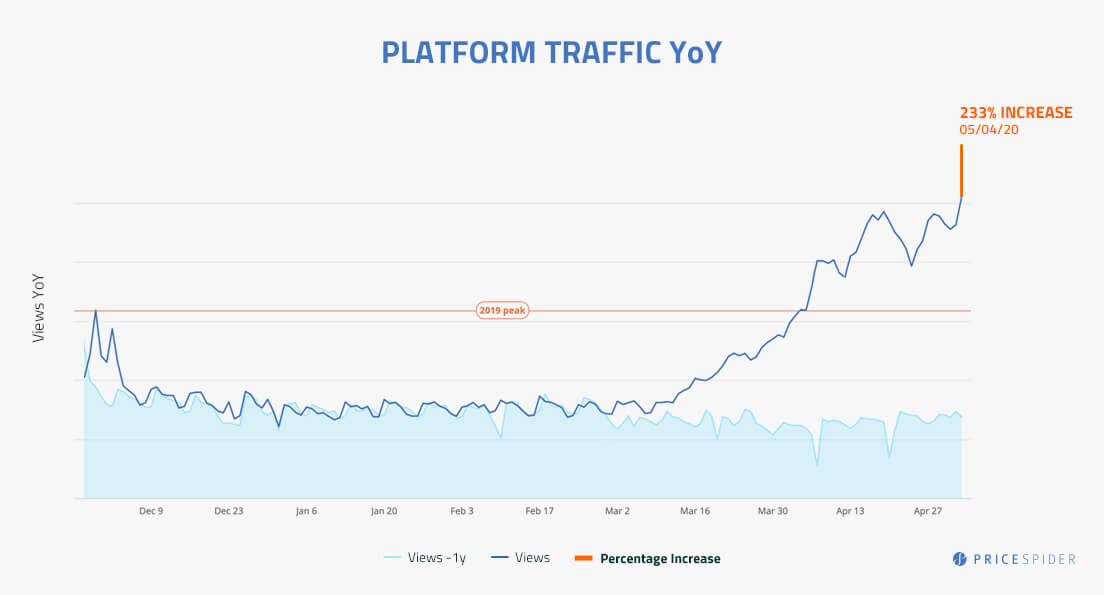On Black Friday of 2019, Americans spent $7.4 billion online. Three days later, they spent a record $9.4 billion on Cyber Monday. But even with a record-breaking holiday season, ecommerce traffic on the PriceSpider Platform has already seen new highs—just a few months later.
Obviously, the COVID-19 pandemic has lasted a lot longer than the five-day period from Thanksgiving to Cyber Monday with continued spikes a few days after Cyber Monday. So it wouldn’t be surprising to see if the sustained increase in ecommerce traffic surpassed last year’s peak holiday shopping traffic. But according to our data, online sales transactions increased by 22% the week of 4-22-2020 to 4-28-2020 compared to Black Friday week 2019, 11-29-2019 to 12-5-2019 and that week had a whopping 59% more product page views.

[Platform Sales Transaction Increase Black Friday 2019 (11/29/2019 to 12/5/2019) compared to week of 4/22/2020 to 4/28/2020.]

[Platform Traffic Increase Black Friday 2019 (11/29/2019 to 12/5/2019) compared to week of 4/22/2020 to 4/28/2020.]
Online pandemic shopping is officially bigger than Black Friday week.
Brands and retailers pull out all the stops to make Black Friday weekend the biggest sales event of the year. And for decades, consumers have been trained to hunt for deals and make major purchases during those five days. It’s no secret that ecommerce sales have dramatically increased as a result of the panic surrounding COVID-19 and stay-at-home orders. But it’s still shocking to see that this spontaneous season of increased ecommerce activity has surpassed the weekend that brands spend months preparing for. To have that number surpassed in views and transactions is pretty crazy. In fact, the platform saw it’s record day in traffic on May 3rd with a 233% increase over the average traffic before the pandemic.

[Platform Traffic % Increase calculated by average traffic from 01/01/2019 to 03/15/2019 compared to weeks of 03/16/2020 to 5/03/2020.]
Here are five possible reasons why online pandemic shopping surpassed Black Friday.
Deals aren’t what’s driving sales
On Black Friday, consumers have been trained to hunt for the best possible deals. In the weeks and months leading up to Black Friday, if someone is considering a big purchase, they may hold off to make sure they get the best price. They’re also planning to buy Christmas gifts for friends and family. People know they’re going to see deals during this period that they won’t find any other time of year.
But that’s not why ecommerce sales are through the roof right now. People have been buying out of panic. They’re trying to buy up stock before the products they need are gone, and they’re trying to get enough to make sure they don’t have to leave the house for more.
People are also buying out of boredom. They’re buying puzzles, game consoles, books, crafts, and especially consumer electronics (our leading industry during this time). People are hunting for things to keep them (and their families) busy at home during this time.
People are buying a wider range of products online
When the stay-at-home orders rolled out and public gatherings were first being discouraged, there was a major spike in people buying food and beverage products online. Historically, this has been a product category people were less willing to purchase online—namely because they wanted to see and feel their groceries in person.
But when going to the grocery store didn’t feel safe, people became much more willing to buy produce and food products online.
And while consumers hunt for gifts and good deals during Black Friday weekend, right now Americans are looking for just about everything online. Household goods. Health and beauty products. Food. Pet supplies. Electronics. Hardware. Automotive parts.
People are buying what they need to finish projects they’ve been putting off. They’re buying things for entertainment. They’re trying to get PPE and cleaning supplies to keep themselves safe and sanitary. But they’re also just trying to avoid leaving the house, so they’re shopping for their basic needs online, too.
Consumers are getting stimulus checks
On average, Americans plan to spend about $400 on purchases over Black Friday weekend. Right now, tax-paying Americans making $75,000 or less annually are receiving a one-time stimulus check for $1,200, with an additional $500 per dependent child.
Many people need this money to pay bills, but the stimulus checks are also an attempt to kickstart the economy. This money is intended to be spent. And whether people are focusing on buying essentials or applying their stimulus check toward a big purchase, they’re most likely going to spend that money online.
At least some of the increase in ecommerce sales is simply because people have money to spend, and buying online is simply more appealing, safe, and accessible than going to a brick-and-mortar store.
Consumer electronics are extremely in-demand
Perhaps one of the biggest surprises of the COVID-19 crisis (from an ecommerce standpoint) is that consumer electronics is the most in-demand product category. With schools switching to online learning, more employees beginning to work remotely, and people simply trying to keep themselves entertained at home, the surge in demand for consumer electronics has surpassed the massive increase in demand that we saw for health and food products.
Brands and retailers are prioritizing online experiences
The coronavirus essentially pulled the plug on brick-and-mortar stores. Businesses that were deemed “unessential” were forced to move online or simply close their doors. And as brands dealt with a massive increase in traffic, it became clear to retailers and manufacturers alike that winning the digital shelf was going to be paramount to their success—maybe even their survival.
Target, in particular, has mastered this moment, prioritizing their buy online, pick-up in-store (BOPIS) option and offering same-day delivery on some purchases. (According to our data, consumers have even been choosing Target more than Amazon during this time.)
As brands and retailers prioritize the digital shelf and optimize their online shopping experience because the alternative is less appealing and less available, it makes sense that we’d see a sharp increase in online transactions and product page views.
Ecommerce is always open
In the coming weeks and months, we’ll likely see many states continue to update stay-at-home orders as coronavirus data evolves. But whether states are open for business or temporarily closed, consumers will continue relying on online brands and retailers to find and buy what they need.
If your brand is still trying to figure out the best way to serve your customers during this time, take a look at our conversion optimization platform. Our Where to Buy tool streamlines the path to purchase and helps consumers find your products in stock. And our suite of other tools helps you create a cohesive shopping experience and protect your brand everywhere it appears.
Schedule a demo to see what PriceSpider can do for you.

